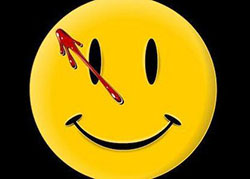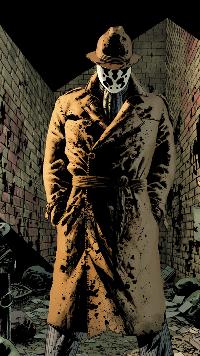
Streetfighting: The Insanity Defense
February 29, 2016
Who you tryin’ to mess with ese?
Don’t you know I’m loco?
“Insane In The Membrane,” Cypress Hill
 There is a lot of discussion about the difference between street fighters and martial artists.
There is a lot of discussion about the difference between street fighters and martial artists.
To understand the difference, we need to fully understand the role of psychology in fighting.
The notion that fighting is “90% mental and 10% physical” has been attributed to many people. This phrase is often used to support the value of sports psychology methods such as visualization or to discuss abstract notions like grit or courage.
I think fighting is 100% mental, in a manner of speaking.
The mind is like the trigger on the gun. You can have a big gun with a heavy caliber round in the chamber, but the gun is no more dangerous than a paperweight until the trigger is pulled. The mind has to tell the fingers to pull the trigger.
The mind has to tell the body when its time to attack.
In On Combat , a book which studied the history of killing in warfare, the military found through battlefield analysis (using metal detectors to pick up ordnance compared with supply records for both sides) that many if not most soldiers in the Civil War and World War II battles studied were firing high or in other ways avoiding killing. Consciously or unconsciously, the soldiers didn’t really want to kill and found subtle ways to avoid it, even in the midst of a battlefield with the enemy shooting back.
It’s easy to underestimate the psychological intensity of the moment of truth, when you are faced with the choice to kill or not to kill, your finger on the trigger, your “enemy” in the cross hairs. We see the act performed casually all the time on TV and in the movies.
If your shot is true, that person’s children will be orphans, his wife a widow, and his unborn children will remain unborn. In real life, that is some heavy shit.
This is why most people have an inborn resistance to killing (or hurting someone badly) and this block may or may not have been addressed in their fight training, either in civilian or military martial arts or combat course.
People who are capable of taking killing actions, quickly and ruthlessly, without hesitation, have a sort of superpower that can equal many years of training, especially if the trained person has not confronted their own pacifist hardwiring.
Even very skilled fighters are walking around with the safety on, perhaps even with a trigger-lock in place. They will be slow to really deploy their weapon. Probably too slow. Violence typically erupts on less than a second, and he who strikes first often wins.

Jackie Earle Haley as Rorschach, unmasked in prison.
“Street” fighters are usually from poor areas where there is a higher incidence of violent crime. They have had to deal with more physical danger and more violent incidents since early childhood. So they are more hardened to violence. I am by no means “street” but I have a stupid sort of pride in what few incidents of violence and danger and police problems I did experience as a kid. This is a common response. People are have a sort of pride about their suffering and that survived and became “hard.” They become proud of what “cred” (street credentials) they have. We are often proud of ourselves for surviving bad situations, even if it was only proximity to violence or living under the oppressive threat of violence.
The television show The Wire followed a group of 8th grade boys growing up in a slum neighborhood in Baltimore. Two them go in opposite directions. Both are pressured by their environment. They get hassled and robbed and generally live under the constant pressure of a predatory hierarchy with no protection from adults or authorities. They have to take care of themselves and this requires a capacity for violence.
There is a turning point and one kid “blinks.” He is beaten (psychologically and literally) and begins to drop his eyes and live in fear and avoidance, surviving as the lowest level of hustler, collecting cans in shopping carts and selling things he finds to the next level up.
The other boy hardens himself, begins to push back and stare down the threatening behavior he encounters. He learns to fight, to shoot, and starts walking around armed. He eventually becomes one of the more dangerous types of predators on the streets, hunting drug dealers, stealing their product and money.
At these least empowered social levels, you’ll find guys who don’t have much but their pride and their capacity for violence. Street fights are often over reputation and pride at some level. This is the “dis” in disrespect. They only have their reputation . The most extreme will kill over an offense. Many will administer a beating to show they are no “bitch.”
So the street fighter’s advantage is they are instantly ready to fight. They expect fights to happen. They are looking for it and waiting for it. Their “safety” is off. The most dangerous are armed and angry. They have a chip on their shoulder and any perceived slight can be a killing offense. These are the guys who will open fire on a crowd. They will pull a knife at the first sign of danger.
Watch City of God for another good examination of how such people are made. Watch Casino or Goodfellas . Joe Pesci’s characters in these films have made up for their small size with their insanity. They have been crazy for so long, its a habit. The violence is casual, even sometimes funny (“am I a joke to you?”). They get a rush from the fear and the anger and walking the scary line where violence can erupt at any moment.
 This was most perfectly captured in the character of Rorschach in the graphic novel
Watchmen
(and the pretty decent movie version).
This was most perfectly captured in the character of Rorschach in the graphic novel
Watchmen
(and the pretty decent movie version).
In Watchmen , only one of the “superheroes” has any real powers (other than genius or fighting skills or Batman-like toys). Most of the other “heroes” mostly just have balls. They are willing to jump into a fight with criminals and throw down.
But the most interesting “hero” is called Rorschach.
Early in the film, we always see Rorschach in his superhero outfit, with a creepy mask with displays shifting Rorschach blots and a cool retro looking hat and overcoat. He looks bad ass, like the ghost of a gangster from a 1940s Noir film. After he is imprisoned, we discover he had lifts in his shoes and in reality, he is really a very small runty looking guy. Kind of sad and beaten. Especially in the comic, you are shocked. This is the guy who was so scary?
But then we discover his secret; his super-power is he’s crazy.
“None of you seem to understand. I’m not locked in here with you. You’re locked in here with me.”
Rorschach
He is vicious. He responds to confrontation immediately, dishing out shocking levels of violence. He is the ultimate bar fighter. At one point, he “interrogates” a random person in a dive bar as everyone stares on in horror. He breaks the guy’s fingers as a room full of scary tough looking guys plead with him to stop. But no one tries to stop him. His reputation precedes him.
In another passage of On Combat , Col. Grossman points out that one of the easiest ways to kill someone is to drive your thumbs through their eyes and through the thin layers of membrane and cartilage into the brain. Why don’t people do this? But we don’t even have to ask, right? Because its gross and horrifying! In all but the hardest criminal and psychopath, we have compartments for our perceptions of the acceptable. Putting your fingers through someone’s eyes into their brain is crossing the “line,” even in a situation where your life is on the line.
Rorschach is the sort of guy who would do it without flinching. If you are on the wrong side of his ethical framework then you are “scum” and for you there is no “unacceptable level of violence” line.
The rest of us are “normal” people who are studying to be fighters. We want to have the “capacity” to fight “if necessary.”
Some martial artists also come from the street or are more street than others, but most martial artists approach fighting from what we might call an “academic” vantage point. They have minimal experience with violence. Their ideas about violence come from the media but also from stories within their art. This is what fighting is like. This is what people will try to do. Ancient fighters did this and that. Some Sifu fifty years ago had a lot of fights and these techniques are based on his experiences.
These martial artists have ordinary lives mostly free from threat, with relationships and kids and family. They go to work and pay their taxes. When a person of this sort trains, they are in a safe place. They are with friends, in the “safe zone.” No matter how competitive it gets, it is extremely rare to have someone seriously hurt. I’ve been studying fighting for over 30 years and I know one case where a guy was kicked and his ACL tore (ending his training permanently). But I wasn’t even there that day. Generally, its as safe as tag football.
So in a confrontation, one of the unlikely dangers is that the opponent is armed. But another, less well-studied possibility, is that they are crazy, or on the spectrum of crazy, and that they might go from 0 to 60 while you are still trying to determine where the ethical line is and when it might have to be crossed.
Your opponent might jump right over the ethical line onto your neck!
This is what many of Geoff Thompson’s early books describe. He was a bouncer for years in a very dangerous urban area. Even the titles of his books tell the story. Three Second Fighter . Dead Or Alive . Street fighters are sucker punchers and vicious finishers, employing boots and improvised and carried weapons. But most of all, they hit first and don’t stop.
Most of us will not have to experience conflict with such a person. But if you are seriously studying fighting and want it to have any relevance on the street beyond being able to handle a drunken co-worker or relative, then you have to consider this sort of person. This is the often the sort of person who starts random fights with strangers. This is the “who are you looking at” guy. The “hey, you bumped into me” guy. The guy who will suddenly be up in your face with the threat of violence.
So how do we address this?
Its unlikely to happen, so you don’t want to get too worried about it or do radical things to prevent it. It’s unlikely, right?
But for me, if you want to be a fighter, you have to be capable and ready, psychologically, to fight, and to fight at the drop of a hat, so to speak.
So for most of us, I think it has to be through the combination of visualization and awareness.
One, you have to understand this problem exists. Then you have to be a little bit on the lookout for it. You have to ask yourself, is this guy crazy? Be open to the possibility that violence can erupt anywhere at any time. Be open to the possibility. Then you have to be willing to possibly provoke the situation a little by starting to gauge the distance (back away a bit from the possibly dangerous person) and build a fence (get your hands up). Sometimes we don’t want to assume or are afraid we will set the person off.
You should .
If someone is acting dangerous, treat them as if there are going to attack.
Listen to your intuition. If you feel threatened, put your hands up. Learn to do it in a “sort-of” friendly way. Practice it in your training. Maybe in a “I talk with my hands” way.
Devote some of your time to occasionally running scenarios through your head. Run it through in different variations.
The guy in your mind is really sketchy looking and asks you for a light then comes at you with a knife. What do you do? This happened to a friend of mine in Holland. He was stabbed when he probably should have kept his distance and then took off running. But he was too trusting. Predators exploit your trust.
Listen to your instincts. Your “Spider-sense” will probably go off – don’t ignore it.
Run various scenarios in your imagination. What would I do if…
In one visualization, a guy seems totally normal but suddenly erupts in anger and swings a chair at your head.
Maybe someone walks into the office and opens fire, as actually happens uncomfortably often.
Usually, the answer is to attack or run. The Wing Chun answer to violence is to attack the attack. But you have to be close enough.
Spin these little propositions in your head and then counter as your style dictates. Reflexively react, in your mind. Give yourself permission to be violent when necessary.
And this is the beauty of Wing Chun. Wing Chun, to some degree, is a crazy guy’s (or girls) style. If done correctly , it innately goes from 0 to 60. Its superpower is its aggression. Its the wolverine of martial arts styles. Its way is to step in and start hitting and to never back down.
Wing Chun is loco.